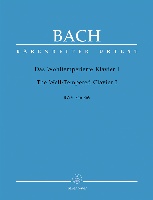Herr Jesu Christ, du höchstes Gut (Lord Jesus Christ,
O highest good), BWV 113, is a church cantata by Johann
Sebastian Bach. He composed the chorale cantata in
Leipzig for the eleventh Sunday after Trinity and first
performed it on 20 August 1724. It is based on the hymn
by Bartholomäus Ringwaldt (1588).
Bach composed the cantata in Leipzig for the Eleventh
Sunday after Trinity as part of his second cantata
cycle and first performed it on 20 August 1724. The
prescribed readings for t...(+)
Herr Jesu Christ, du höchstes Gut (Lord Jesus Christ,
O highest good), BWV 113, is a church cantata by Johann
Sebastian Bach. He composed the chorale cantata in
Leipzig for the eleventh Sunday after Trinity and first
performed it on 20 August 1724. It is based on the hymn
by Bartholomäus Ringwaldt (1588).
Bach composed the cantata in Leipzig for the Eleventh
Sunday after Trinity as part of his second cantata
cycle and first performed it on 20 August 1724. The
prescribed readings for the Sunday were from the First
Epistle to the Corinthians, on the gospel of Christ and
his (Paul's) duty as an apostle (1 Corinthians
15:1–10), and from the Gospel of Luke, the parable of
the Pharisee and the Tax Collector (Luke
18:9–14).
The text of the cantata is based on the eight stanzas
of Bartholomäus Ringwaldt's hymn (1588), a song of
penitence related to the tax collector's prayer "Herr,
sei mir armem Sünder gnädig" (God be merciful to me a
sinner). The melody is also attributed to Ringwaldt. An
unknown poet kept the words unchanged in movements 1,
2, 4 and 8, but inserted recitative in movement 4. He
transcribed the ideas of the remaining stanzas to arias
and a recitative, keeping the beginning of stanzas 3
and 7. He treated stanzas 5 and 6 most freely,
including ideas from the epistle such as the promise of
mercy, which is only asked, not promised, in the
chorale. He refers to several verses from different
gospels to underscore that thought, Luke 15:2 in both 5
and 6, Matthew 9:2 (parallel Luke 7:48) in 5, and
Matthew 11:28 in 6, paraphrased as "Er ruft: Kommt her
zu mir, die ihr mühselig und beladen" (He calls: come
here to Me, you who are weary and burdened). The last
verse also appears in Handel's Messiah, turned in the
third person: "Come unto Him, all ye that labour", in
the soprano section of He shall feed His flock like a
shepherd.
The opening chorus is a chorale fantasia with the
cantus firmus in the soprano, the lower voices set in
homophony contrasting to an embellished melody in the
soprano. The lines of the chorale are separated by an
independent ritornello of the orchestra. Its theme is
derived from the chorale melody. A solo violin in
virtuoso figuration plays throughout, while the oboes
and the other strings are silent during the vocal
passages. The second movement treats the chorale in the
same way as some of the movements which Bach
transcribed to the Schübler Chorales, as a trio of the
alto, the violins in unison, and the continuo. Here the
chorale melody appears unadorned.
The first aria is accompanied by the two oboes d'amore.
The theme is related to the chorale melody, but turned
to the major mode and in a swinging 12/8-time. The
voice picks up the same theme and elaborates the word
"gewandelt" (changed) in an extended coloratura.
Musicologist Boyd notes a similarity to the aria Et in
Spiritum sanctum from Bach's later Mass in B minor,
both are for the bass, in a compound time, in A major
and with two oboes. The second aria, movement 5, is
accompanied by an obbligato flute, as in the cantatas
of the two preceding weeks, Was frag ich nach der Welt,
BWV 94, and Nimm von uns, Herr, du treuer Gott, BWV
101. The recitative, movement 6, is accompanied by the
strings, after four movements without them. They enter
in the second measure on the words "wie lieblich klingt
das Wort in meinem Ohren!" (how sweetly this word rings
in my ears!), called a "magical moment" by Craig Smith.
The recitative culminates in the prayer of the tax
collector. The last aria is set for two voices and
continuo, concentrated on the words without ritornellos
like a chorale concerto of the 17th century. The
chorale melody in embellished form appears in several
lines, even on words other than the original text. The
final stanza is set for four parts.
Source: Wikipedia
(http://en.wikipedia.org/wiki/Herr_Jesu_Christ,_du_h%C3
%B6chstes_Gut,_BWV...)
Although originally composed for alto, violin and basso
continuo, I created this arrangement for Concert
(Pedal) Harp.





 Faire un don
Faire un don